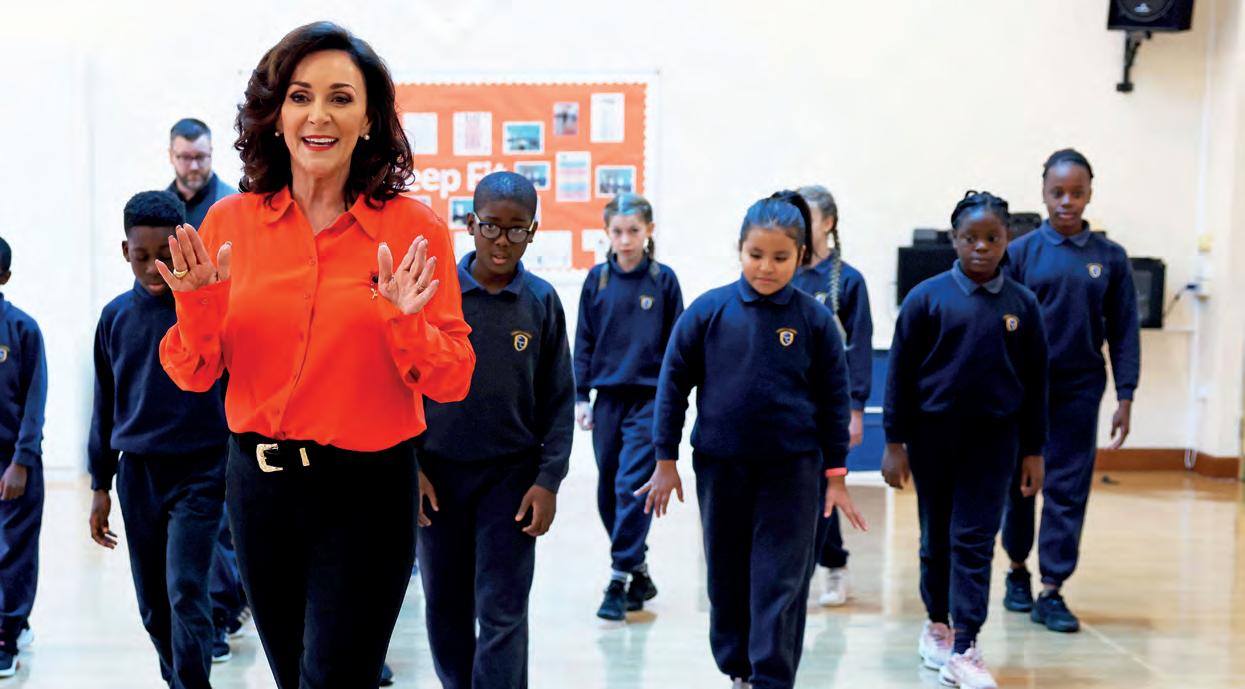
11 minute read
Join the movement – Let’s Dance!
We highlight the impact of our dance community and speak to Shirley Ballas and Angela Rippon.
We all believe in securing a bright future for dance. In 2024, we published Dance for All – Extending Our Ambition for Dance in the UK, outlining our commitment to collaborating across the sector to promote the value of dance and speak with one voice.
As our members, you are already changing lives, promoting health and wellbeing, and enriching our vibrant culture. As our President, Shirley Ballas, states in her foreword to the Dance for All report: “Dance does so much for us all – it builds confidence, inspires creativity and friendships, and makes us feel good about ourselves.”
Lets Dance! is a new national campaign spearheaded by ISTD Grand Council member, Angela Rippon.
Let’s Dance!
You bring the vision of Dance for All to life every day through your teaching and dedication. With Let’s Dance! you now have a new opportunity to showcase the incredible work you’re already doing.
This national campaign celebrates your passion for dance and invites even more people to experience its benefits. Together, we can spread the joy of dance and demonstrate how it strengthens bodies, minds, and communities across the UK.
Let’s Dance! is founded by ISTD Grand Council member Angela Rippon and features our President, Shirley Ballas, as one of its ambassadors.
On 2 March 2025, Let’s Dance! will get the whole nation moving, and we invite you to join the movement! Here are some ways to participate:
• Open your existing dance classes to new participants.
• Host an open studio event.
• Partner with a local school to offer a taster class.
• Organise a ‘bring a friend to dance’ session.
• Create exciting taster classes and collect contact details for future follow-up.
• Promote the event through local media or on your social media platforms.
• Use the Let’s Dance! logo in your marketing materials to show your support.
• Share health benefits and statistics about dance to highlight its positive impact.
How you choose to get involved is up to you – you know best! What if 2 March doesn’t work for you? No problem – other dates are also fine! Find out more about how to get involved and download marketing assets here: www.istd.org/discover/lets-dance


Resources to help you
1. Promote your ISTD credentials: Showcase your qualifications and association with the ISTD to highlight your expertise and attract potential students. Visit: www.istd.org/dance/the-mark-of-quality-teaching
2. Update your details on Find a Dance Teacher: Ensure your contact information, class offerings, and other details are up-to-date on the ISTD's Find a Dance Teacher directory to help people easily find you. Visit: istd.org/find-a-teacher
3. Use resources from the Find Your Dance Space campaign: Leverage materials from this campaign to reach out to local schools, health professionals, and communities to introduce your dance school. These resources also help demonstrate the physical and mental health benefits of dance. Visit: www.istd.org/findyourdancespace
4. Take part in Let’s Dance! on 2 March 2025 (or other dates that suit): Join the biggest dance event the UK has ever hosted. It’s an open invitation for everyone to celebrate dance in a fun and inclusive way. Visit: www.istd.org/discover/lets-dance
If you believe that you have the makings of a good media moment you can share it with the Let’s Dance! team via the form on our website: www.istd.org/discover/lets-dance

Log in to access your resources today.

Angela Rippon
We asked our ISTD Grand Council member about her hopes for her Let’s Dance! project.
We last interviewed Anglela in issue 476 of Dance magazine in 2016, after more than five million viewers watched the BBC’s How to Stay Young, which she hosted alongside Dr Chris van Tulleken. At the time, Angela was 71 and revealed scientific evidence suggesting that dance is one of the best ways to stay fit in later years. Since then, at 79, she participated in the BBC’s Strictly Come Dancing in 2023, which sparked her idea for Let’s Dance!. Now, at 80, she's once again inspiring the nation to dance through Let’s Dance!
Dance teachers are brilliant role models for all students – regardless of age.
What are your hopes for the Let’s Dance! campaign, both now and in the future?
My ambition is to get the nation dacing. Most peoople love watching dance as an entertainment, either in the theatre or on television. But dance has proved to be one of the finest forms of exercise for mind and body regardless of age or experience. Because it exercises every part of your body from head to toe, and you also have to use your brain to remember the steps. Also, unlike other forms of exercise – it’s fun. You laugh, you smile, you release endorphins that make you feel good. And you make friends in a way you might never do just running or going to the gym. You will never be lonely or isolated if you go to a dance class. So however you look at it, dance ticks every box to get you fit, strong, well balanced and healthy, throughout your life.
Do you have a message for our ISTD members who are sharing their passion for dance with their students daily?
Dance teachers are brilliant role models for all students –again regardless of age. You can share and pass on your expertise and knowledge. Help your students to grow and express themselves. Become mentors and friends. And most importantly share your passion and joy for dance.
How has your personal experience of the benefits of dance motivated you to spearhead the Let’s Dance! campaign?
I have been involved with dance in one way or another since I was about five years old and was sent to a dance class to sort out my knock knees. I learnt tap, modern and ballet at a dance school in Plymouth. Going to class every Saturday morning until I was 17. I still go to a Silver Swans ballet class whenever I can to keep my core strength, balance, and flexibility. It’s my way of investing in my wellness pension pot. So that as I pass my 80th birthday I’m still flexible, strong, balanced and loving to dance. I just wish that everyone can experience the way that dance can change your life. Keep you fit and well, and ensure that as you grow older, you maintain that core strength, and most importantly, the balance that will save you from having a serious fall. Broken bones from falls put more people over 60 into hospital than any accident or illness. And sadly, the risk or anxiety of having another fall can rob many older people of their independence. So, dance for fun, for good balance and a healthy old age.
Do you have a favourite dance teacher who really inspired and helped you?
My very first teacher was Miss Valerie Lamb at the Geraldine Lamb School of Dance in Plymouth. She gave me the confidence to be myself, and love to dance. More recently my dear friend Sue Hadley of the Suella School in Torquay, Devon has been a true inspiration. In spite of a serious stroke some years ago, that has left her mostly confined to a wheelchair, she still teaches from the chair. She has grace, body tone, and a lifelong passion for dance that she passes on to and shares with her students. Finally, my Strictly partner Kai Widdrington is a great dancer and terrific teacher. He challenged me, coaxed and coached me. He helped me discover that I could do things I had no idea I could do (who knew I could do the double splits that we did in the rumba – I certainly didn’t) and made my Strictly experience one of the most enjoyable things I have ever done on television.
What is your opinion of the motivational benefits of taking dance examinations?
As a tap and ballet student I took all my exams up to Intermediate level. I found the challenge and discipline of taking exams, at times a bit stressful, but always rewarding. I think it made me realise, even as a young person, that you gain in confidence, and self-awareness, as you feel yourself grow and get better at something that is important to you. I knew I was never going to be good enough to become a professional dancer. But the experience of preparing for exams, learning new skills and working to perfect them, combined with the discipline of hard work and commitment, was a good life lesson that prepared me for the challenges of working and surviving in my career.
Dance is one of the best all-round exercises for mind and body, for any age and any level of experience and fitness.
Can you tell us more about the scientific evidence that clearly demonstrates the physical and mental health benefits of dance?
During the making of the television series I did with Chris van Tulleken, How to Stay Young, I went to Germany where one of the universities did an evaluated test pitting dancers over 60 against people over 60 exercising in a gym. And the dancers came out on top after six months as being stronger, fitter and more supple, in every scientific and medical test they were put through.
When I began researching material to back up my Let’s Dance! project, I found so many reports from medical and scientific researchers, all concluding that dance is one of the best all round exercises for mind and body, for any age and any level of experience and fitness. It ticks all the boxes. I have some 15 reports on my desk all outlining the incredible benefits of dance in maintaining and improving health and fitness.
So yes, there is a ton of evidence-based material to back up our goal to help people take control of their health and wellness by dancing. Talk to the people who run Parkinson’s UK and they will tell you that dance has a “miraculous” effect on people with Parkinson’s as it helps them to control their uncontrollable movements. Classes held for people with dementia, produce remarkable results in those who have become withdrawn, or silent. They react to the music with genuine joy and self-expression. The Chelsea and Westminster hospital take dance into ICU wards to encourage movement in those who are seriously ill and provide dance classes for outpatients to help with recovery.
Angela Rippon explains more here: www.istd.org/discover/lets-dance
Shirley Ballas
Our ISTD President and ambassador for Let’s Dance! shares her perspective.

Dance does so much for us all – it builds confidence, inspires creativity and friendships, and makes us feel good about ourselves.
What made you want to be an ambassador for Let’s Dance?
Well, dance has been a part of my life since the age of three when I started ballet classes, so I know first-hand the benefits on both physical and mental health. When I heard about Let’s Dance! and its aim to bring people together through dance and encourage those that don’t usually dance to give it a go I just knew I had to become an ambassador.
Why is Let’s Dance! a great opportunity for ISTD members?
I feel any opportunity to dance is a great one for ISTD members, and this event in particular will get people dancing. You’ll get the chance to do what you love, meet ISTD members and I’m sure even enrol a few new students along the way too. It’s going to be a fabulous event.
What role do you see dance teachers playing in this initiative, and how can they contribute to its success?
Dance teachers are going to be at the heart of Let’s Dance! Hosting a class, spreading the word, encouraging signups will contribute to the success as the more people dancing the better. They are going to inspire thousands of participants through their events, and I can’t wait to see what everyone gets up to.
What advice would you give to those who are hesitant to try dance for the first time? How can we make it more approachable?
If you can move to music, stay in time and enjoy yourself then really that’s all that matters. Don’t be frightened of making mistakes, it’s how we learn. Everybody has to start somewhere.
What strategies do you recommend for dance teachers to engage their local communities and encourage more people to participate in dance activities?
Social media now plays a huge role in events like this. So, to all the dance schools and dancers out there I’m sure a few Instagram stories will help make a difference. You’d be surprised by how many people you can reach. It’d also be great to see some posters in as many dance schools as possible, perhaps some leaflets on reception desks would work well.



